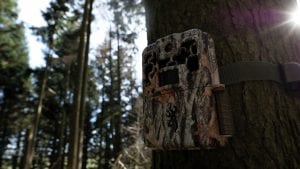Article by Ed Snell – Project Support & Development at NatureSpy
Since 2018, NatureSpy been running 50 camera traps in forests in the North York Moors National Park. These cameras are primarily in place as part of the Yorkshire Pine Marten Project, but they have also created an opportunity to compile a rich wildlife dataset to support other conservation efforts and research projects. During our Heritage Lottery-funded project from 2018-2021, we created and submitted 14,670 wildlife records to the North and East Yorkshire Ecological Data Centre, all thanks to the help of our brilliant volunteers who patiently worked through thousands of camera trap videos.

A camera trap watches on…
Our Yorkshire project has been using a set of Browning Recon Force Advantage camera traps (now superseded by the Browning Recon Force Elite HP5) that have been in almost constant use since 2018, with routine maintenance every two months to check memory cards and batteries. During cooler, damper months, we carry out a some extra maintenance to keep the cameras working consistently well, click here to learn some simple camera trap maintenance tips.
These camera traps are normally set to 20-second video mode. A 5-minute delay is used between captures and the repeat appearance of one species on camera within a 30-minute window is not rerecorded, so to reduce the effect of recounting the same individual animal. Due to a high volume of grey squirrel and wood mouse captures, we only record these species once per camera site.
Several different camera trap survey methodologies are used to decide how and where we set out the cameras, combining more structured scientific methods and more flexible approaches to explore areas of interest, full details can be found on page 13 of this report.
Project volunteers installing a camera trap
The Yorkshire Pine Marten Project is run in partnership with Forestry England and our core focus is on Forestry England forests in the North York Moors National Park. These forests are largely characterised by coniferous forestry, but also contain pockets of mixed and mature broadleaf woodland, so a broad spectrum of forest habitat types is covered by the cameras. Occasionally, cameras are placed near to streams within these forests, which provides an opportunity to capture footage of semi-aquatic mammals such as otters, as well as waterfowl.
Our cameras cover over 100km2 of forest, with a core focus on the following forests: Dalby, Langdale, Cropton, Wykeham, Sneaton, Broxa, Guisborough, Silton, Gilling, Kilburn, Oldstead, Wass, Pry Rigg and Boltby.
On fieldwork in Wykeham Forest, North York Moors
Surveying a large area with camera traps for multiple years can build a clear picture of wildlife activity on the ground, but importantly, also shines a light on what’s absent too.
Red squirrels have been absent from the North York Moors for some time now and our cameras confirm this in the forests we’re surveying. In 2022, we recorded footage of a pine marten preying on grey squirrel in Yorkshire, which could be good news for red squirrels in the future. Learn more about how pine martens are proving to be a helping hand in red squirrel conservation here.
We’ve not recorded any footage of muntjac deer on the North York Moors, despite their movement into North Yorkshire. There are three species of deer we catch on camera regularly on the North York Moors, learn more about Yorkshire’s deer species here.
Small mammals can be some of the most challenging species to confidently identify from regular camera trap setups, as normal traps use lenses that typically work best at a range of around 3 – 15 metres. For crisp images of small mammals, that range needs to be reduced to within 50cm and requires a close-lens setup. Wood mice are by far the most common small mammal species we’ve caught on camera; their large eyes have a unique glow at night that helps with identification. Two of the more challenging small mammals to tell apart from camera trap footage have been common shrews and pygmy shrews.
We occasionally see bats on our cameras too, but identification to species level is challenging unless it’s possible to pull a clear still image from a video. Regular camera trap setups are not effective for identifying bats, they are however a nice species to see zipping past the cameras at night!
There are plenty of bird species that we see and hear when out on fieldwork that are highly skilled at avoiding our cameras. For example, there are areas where we’ll hear crossbills chattering away in the tops of the pines, but since they tend to stay up high, we’ve not had one visit a camera on the ground.
Pine martens are one of the rarest mammals on the North York Moors
We have gathered camera trap records for the following species in forests in the North York Moors National Park since 2018.
Mammals
Birds